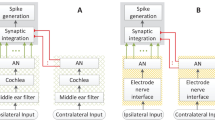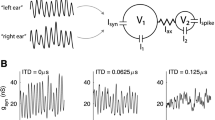Abstract
Computer simulations of a network model of an isofrequency patch of the dorsal cochlear nucleus (DCN) were run to explore possible mechanisms for the level-dependent features observed in the cross-correlograms of pairs of type IV units in the cat and nominal type IV units in the gerbil DCN. The computer model is based on the conceptual model (of a cat) that suggests two sources of shared input to DCN's projection neurons (type IV units): excitatory input from auditory nerves and inhibitory input from interneurons (type II units). Use of tonal stimuli is thought to cause competition between these sources resulting in the decorrelation of type IV unit activities at low levels. In the model, P-cells (projection neurons), representing type IV units, receive inhibitory input from I-cells (interneurons), representing type II units. Both sets of model neurons receive a simulated excitatory auditory nerve (AN) input from same-CF AN fibers, where the AN input is modeled as a dead-time modified Poisson process whose intensity is given by a computationally tractable discharge rate versus sound pressure level function. Subthreshold behavior of each model neuron is governed by a set of normalized state equations. The computer model has previously been shown to reproduce the major response properties of both type IV and type II units (e.g., rate-level curves and peri-stimulus time histograms) and the level-dependence of the functional type II-type IV inhibitory interaction. This model is adapted for the gerbil by simulating a reduced population of I-cells. Simulations were carried out for several auditory nerve input levels, and cross-correlograms were computed from the activities of pairs of P-cells for a complete (cat model) and reduced (gerbil model) population of I-cells. The resultant correlograms show central mounds (CMs), indicative of either shared excitatory or inhibitory input, for both spontaneous and tone-evoked driven activities. Similar to experimental results, CM amplitudes are a non-monotonic function of level and CM widths decrease as a function of level. These results are consistent with the hypothesis that shared excitatory input correlates the spontaneous activities of type IV units and shared inhibitory input correlates their driven activities. The results also suggest that the decorrelation of the activities of type IV units can result from a reduced effectiveness of the AN input as a function of increasing level. Thus, competition between the excitatory and inhibitory inputs is not required.
Similar content being viewed by others
References
Adams JC, Warr WB (1976) Origins of axons in the cat's acoustic striae determined by injection of horseradish peroxidase into severed tracts. J Comp Neurol 170:107–121.
Arle JE, Kim DO (1991) Simulations of cochlear nucleus neural circuitry: excitatory-inhibitory response-area types I–IV. J Acoust Soc Am 90:3106–3121.
Benson TE, Voigt HF (1995) Neuron labeling by extracellular delivery of horseradish peroxidase in vivo: a method for studying the local circuitry of projection and interneurons at physiologically characterized sites. J Neurosci Methods 57:81–91.
Berrebi AS, Mugnaini E (1991) Distribution and targets of the cartwheel cell axon in the dorsal cochlear nucleus of the guinea pig. Anat Embryol 183:427–454.
Brawer JR, Morest DK, Kane EC (1974) The neuronal architecture of the cochlear nucleus of the cat. J Comp Neurol 155:251–300.
Cohen ES, Brawer JR, Morest DK (1972) Projections of the cochlea to the dorsal cochlear nucleus in the cat. Exp Neurol 35:470–479.
Davis KA (1995) Neural correlations in the dorsal cochlear nucleus of unanesthetized, decerebrate Mongolian gerbil. PhD dissertation. Boston University, Boston, Mass.
Davis KA, Voigt HF (1994) Neural modeling of the dorsal cochlear nucleus: cross-correlation analysis of short-duration tone-burst responses. Biol Cybern 71:511–521.
Davis KA, Voigt HF (1996a) Neural correlations in the unanesthetized decerebrate gerbil dorsal cochlear nucleus. In preparation.
Davis KA, Voigt HF (1996b) Response properties of units in the dorsal cochlear nucleus of unanesthetized, decerebrate gerbil recorded with metal electrodes. In preparation.
Davis KA, Ding J, Benson TE, Voigt HF (1996) Response properties of units in the dorsal cochlear nucleus of unanesthetized, decerebrate gerbil. J Neurophysiol 75:1411–1431.
Ding J, Benson TE, Voigt HF (1994) Physiology and morphology of neurons in dorsal and posteroventral cochlear nucleus of unanesthetized, decerebrate gerbils (Meriones unguiculatus). Abstr Assoc Res Otolaryngol 17:17.
Evans EF, Nelson PG (1973a) The responses of single neurones in the cochlear nucleus of the cat as a function of their location and the anaesthetic state. Exp Brain Res 17:402–427.
Evans EF, Nelson PG (1973b) On the functional relationship between the dorsal and ventral divisions of the cochlear nucleus of the cat. Exp Brain Res 17:428–442.
Fekete DM, Rouiller EM, Liberman MC, Ryugo DK (1984) The central projections of intracellularly labeled auditory nerve fibers in cats. J Comp Neurol 229:432–450.
Hancock KE, Kimura SR, Davis KA, Voigt HF (1994) Modeling inhibition of type II units in dorsal cochlear nucleus. Ann Biomed Eng 22:52.
Hill AV (1936) Excitation and accommodation in nerve. Proc R Soc Lond Ser B 119:305–355.
Kane EC (1974) Synaptic organization in the dorsal cochlear nucleus of the cat: a light and electron microscopic study. J Comp Neurol 155:301–329.
Liberman MC (1978) Auditory-nerve responses from cat raised in a low-noise chamber. J Acoust Soc Am 63:442–455.
Lorente de Nó R (1981) The primary acoustic nuclei. Raven Press, New York.
MacGregor RJ, Oliver RM (1974) A model for repetitive firing in neurons. Biol Cybern 16:53–64.
McMullen TA, Voigt HF (1984) Neuronal circuitry of the dorsal cochlear nucleus: a computer model. Soc Neurosci Abstr 10:842.
Melssen EG, Epping WJM (1987) Detection and estimation of neural connectivity based on cross-correlation analysis. Biol Cybern 57:403–414.
Moore GP, Segundo JP, Perkel DH, Levitan H (1970) Statistical signs of synaptic interaction in neurons. Biophys J 10:876–900.
Mugnaini E (1985) GABA neurons in the superficial layers of rat dorsal cochlear nucleus: light and electron microscopic immunocytochemistry. J Comp Neurol 235:61–81.
Mugnaini E, Osen KK, Dahl AL, Freidrich VL Jr, Korte G (1980a) Fine structure of granule cells and related interneurons (termed Golgi cells) in the cochlear nuclear complex of cat, rat and mouse. J Neurocytol 9:537–570.
Mugnaini E, Warr WB, Osen KK (1980b) Distribution and light microscopic features of granule cells in the cochlear nuclei of the cat, rat and mouse. J Comp Neurol 191:581–606.
Oertel D, Wu SH (1989) Morphology and physiology of cells in slice preparations of the dorsal cochlear nucleus of mice. J Comp Neurol 283:228–247.
Osen KK (1969) Cytoarchitecture of the cochlear nuclei in the cat. J Comp Neurol 136:453–482.
Osen KK (1970) Course and termination of the primary afferents in the cochlear nuclei of the cat: an experimental anatomical study. Arch Ital Biol 108:21–51.
Osen KK, Mugnaini E (1981) Neuronal circuits in the dorsal cochlear nucleus. In: Syka J, Aitkin L (eds) Neuronal mechanisms of hearing. Plenum Press, New York, pp 119–125.
Perkel DH, Gerstein GL, Moore GP (1967) Neuronal spike trains and stochastic point processes. II. Simultaneous spike trains. Biophys J 7:419–440.
Pont MJ, Damper RI (1991) A computational model of afferent neural activity from cochlea to the dorsal acoustic stria. J Acoust Soc Am 89:1213–1228.
Sachs MB, Winslow RL, Sokolowski BH (1989) A computational model for rate-level functions from cat auditory-nerve fibers. Hear Res 41:61–70.
Saint-Marie RL, Benson CG, Ostapoff EM, Morest DK (1991) Glycine immunoreactive projections from the dorsal to the anteroventral cochlear nucleus. Hear Res 51:11–28.
Schwartz IR, Yu S-M, DiCarlantonio G (1987) Neuronal cell types in the gerbil cochlear nucleus: correlation with GABA immunoreactivity. Abstr Assoc Res Otolaryngol 10:64.
Shofner WP, Young ED (1985) Excitatory/inhibitory response types in the cochlear nucleus: relationships to discharge patterns and responses to electrical stimulation of the auditory nerve. J Neurophysiol 54:917–939.
Spirou GA, Young ED (1991) Organization of dorsal cochlear nucleus type IV unit response maps and their relationship to activation by bandlimited noise. J Neurophysiol 66:1750–1768.
Sydorenko MR (1992) Analysis of functional connectivity in the cat dorsal cochlear nucleus. PhD dissertation, The Johns Hopkins University, Baltimore, Md.
Voigt HF, Davis KA (1990) Computer simulations of neural correlations in dorsal cochlear nucleus. In: Ainsworth WA (ed) Cochlear nucleus: structure and function in relation to modeling. JAI Press, London (In press).
Voigt HF, McMullen TA (1984) Simulation of neuronal circuitry of the dorsal cochlear nucleus. Abstr Assoc Res Otolaryngol 7:67.
Voigt HF, Young ED (1980) Evidence of inhibitory interactions between neurons in the dorsal cochlear nucleus. J Neurophysiol 44:76–96.
Voigt HF, Young ED (1985) Stimulus dependent neural correlation: an example from cochlear nucleus. Exp Brain Res 60:594–598.
Voigt HF, Young ED (1988) Neural correlations in the dorsal cochlear nucleus: pairs of units with similar response properties. J Neurophysiol 59:1014–1032.
Voigt HF, Young ED (1990) Cross-correlation analysis of inhibitory interactions in dorsal cochlear nucleus. J Neurophysiol 64: 1590–1610.
Westerman LA, Smith RL (1984) Rapid and short-term adaptation in auditory nerve responses. Hear Res 15:249–260.
Wickesberg RE, Oertel D (1988) Tonotopic projection from the dorsal to the anteroventral cochlear nucleus of mice. J Comp Neurol 268:389–399.
Winter IM, Palmer AR (1995) Level dependence of cochlear nucleus onset unit responses and facilitation by second tones or broadband noise. J Neurophysiol 73:141–159.
Wouterlood FG, Mugnaini E (1984) Cartwheel neurons of the dorsal cochlear nucleus: a Golgi-electron microscopic study in rat. J Comp Neurol 227:136–157.
Wouterlood FG, Mugnaini E, Osen KK, Dahl AL (1984) Stellate neurons in rat dorsal cochlear nucleus studied with combined Golgi impregnation and electron microscopy: synaptic connections and mutual coupling by gap junctions. J Neurocytol 13:639–664.
Young ED (1980) Identification of response properties of ascending axons from dorsal cochlear nucleus. Brain Res 200:23–38.
Young ED, Brownell WE (1976) Responses to tones and noise of single cells in dorsal cochlear nucleus of unanesthetized cats. J Neurophysiol 39:282–300.
Young ED, Voigt HF (1982) Response properties of type II and type III units in dorsal cochlear nucleus. Hear Res 6:153–169.
Zhang S, Oertel D (1993) Tuberculoventral cells of the dorsal cochlear nucleus of mice: intracellular recordings in slices. J Neurophysiol 69:1409–1421.
Author information
Authors and Affiliations
Rights and permissions
About this article
Cite this article
Davis, K.A., Voigt, H.F. Computer simulation of shared input among projection neurons in the dorsal cochlear nucleus. Biol. Cybern. 74, 413–425 (1996). https://doi.org/10.1007/BF00206708
Received:
Accepted:
Issue Date:
DOI: https://doi.org/10.1007/BF00206708




